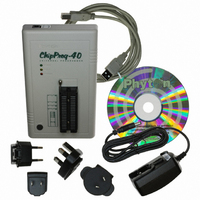CHIPPROG-40 Phyton Inc, CHIPPROG-40 Datasheet - Page 11

CHIPPROG-40
Manufacturer Part Number
CHIPPROG-40
Description
PROGRAMMER STANDALONE 40-DIP
Manufacturer
Phyton Inc
Type
Universal, Stand Aloner
Specifications of CHIPPROG-40
Contents
Programmer, Cables, CD, Power Adapter
Ic Product Type
Programmer, Universal
Ic Interface Type
USB
Features
Embedded Script Language For Automation Of Routine Operations, Splits Files To Multiple Images
Rohs Compliant
Yes
For Use With/related Products
EEPROM, EPROM, FLASH, MCU, NVRAM
Lead Free Status / RoHS Status
Lead free / RoHS Compliant
- Current page: 11 of 182
- Download datasheet (7Mb)
© 2010 Phyton, Inc. Microsystems and Development Tools
1.2
System Requirements
ISP JTAG Mode
ISP HV Mode
Project
Buffers are intermediate layers between the data in files and the data in the target device. The
ChipProg enables no direct interaction between the files and target devices. All the file operations,
such as loading and saving files are applicable to the buffers only. All the physical manipulations with
the target device memory content pass through the buffers as well. This is a fundamental principle of
the programmer operations with data and devices
To run ChipProgUSB and to control a ChipProg programmer, you need an IBM PC-compatible computer
with the following components:
Pentium-III CPU or higher
Windows XP/Vista/7 for the ChipProg-48, ChipProg-40 and ChipProg-ISP programmers in the all
modes
Windows 98/ME for the ChipProg-48, ChipProg-40 and ChipProg-ISP programmers in the basic mode
Windows 2000/XP/Vista/7 for the ChipProg-G4 programmer
Windows XP/Vista/7 for using the Application Control Interface control
256MB of RAM
At least one USB port
A hard drive with at least 200MB of free space
File - Buffer - Target structure
Examples of the buffer's layer structures of different devices:
1. In the Intel 87C51FA microcontroller each opened buffer includes two layers: Code and
2. In the Microchip PIC16F84 microcontroller each opened buffer includes three layers: Code, Data
Each buffer layer can be opened for watching or editing by clicking its tab on the top of the buffer
window.
Encryption table.
EEPROMIdentifier locations.
one mode may exist for one device.
In-system programming via a JTAG interface.
In-system programming that requires applying a relatively high voltage to
the target device, (12V for example).
An integrated set of information in the ChipProgUSB that completely
describes the target device, properties of the data buffers, programming
options and settings, list of the source and destination files with all their
properties, etc.. Each project that has its own unique name can be stored
and promptly reloaded for immediate execution. Usually a user creates a
project to work with one type of device. Working with projects saves a lot of
time for the initial configuration of the programmer every time you start
working with a new device.
Introduction
11
Related parts for CHIPPROG-40
Image
Part Number
Description
Manufacturer
Datasheet
Request
R

Part Number:
Description:
Diodes (General Purpose, Power, Switching) HIREL
Manufacturer:
Infineon Technologies

Part Number:
Description:
RF Bipolar Small Signal HIREL
Manufacturer:
Infineon Technologies

Part Number:
Description:
RF Bipolar Small Signal HIREL
Manufacturer:
Infineon Technologies

Part Number:
Description:
RF Bipolar Small Signal HIREL
Manufacturer:
Infineon Technologies










